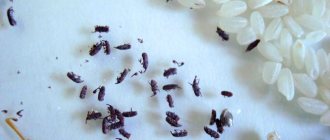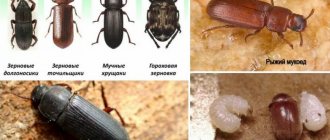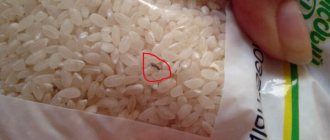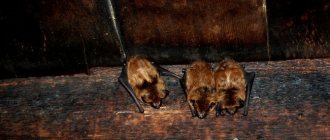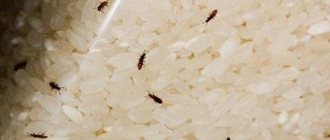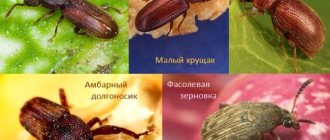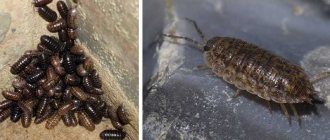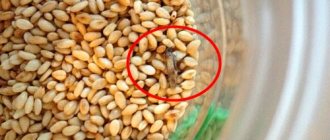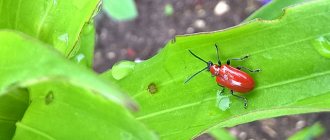Why do bugs appear in cereals, how to get rid of pests and which cereals are most susceptible to their influence? First of all, you need to understand that bugs only appear where there is constant access to food. Insects are attracted to loose materials not only in open containers and bags, but also when scattered on shelves and in cabinets.
Cereals and pasta are a favorite treat not only for bugs, but also for food moths. Insects also actively eat cereals, crackers, dried fruits, bread; they can be found in spices and food concentrates.
What bugs are found in the kitchen and how do they get there?
It’s not enough to discover that there are bugs in flour and cereals, damaging products with lightning speed. To choose effective pest control products, you need to clearly know what type they belong to. There are several main types of bugs that damage bulk products:
- bread grinder;
- flour bug;
- red mucous eater;
- food moth.
Bread grinders are miniature light brown bugs that can fly; they most often settle in cereals; they enjoy baked goods, old medicinal herbs, as well as tea and coffee with great pleasure. They enter the apartment with contaminated store products, as well as animal feed.
Flour bugs settle in flour more often than in any other product; they can often be found in bags of starch. Insects simply penetrate boxes in the kitchen with bulk products, including packages of rye, rice flour, rolled oats and semolina. Infrequently, you can see pests in dried fruits, rice or buckwheat.
The peculiarity of insects is the ability to reproduce quickly. Female beetles camouflage their oviposition in crevices of furniture in the kitchen, in cereals, flour, and on cabinet shelves. A new generation of pests quickly spreads throughout the home in search of food sources.
The red common mucoed is no more than 2.5 mm long. It most often enters the premises together with low-quality animal feed. The pest’s favorite food is cereals, grains, flour with an expired shelf life and a moisture content of no more than 15%. In order for the red flour beetle to stop spoiling food and breeding in the kitchen, it is enough to block access to food sources.
The food moth infests in buckwheat, rolled oats, semolina, rice, flour. A mature individual visually resembles a silver butterfly and reaches a length of 10 cm. Its appearance in the kitchen is associated with violation of food storage rules; in addition, the insect enters the house through ventilation holes and open windows.
In addition to the fact that insects are found in semolina, millet and other cereals, in some cases tea and cocoa, dried fruits, and pasta are also infected.
It is not difficult to identify pests in products - they leave behind a thin web woven from small yellow worms.
Where do the bugs hide?
Parasites live in secluded places in the kitchen, and not only in grain crops. Preparing a folk remedy for poisoning is not the wisest decision. This is due to the persistence of parasites in the most unexpected places. Here are some examples:
- spices and medicines. Favorite medium: mustard plasters, pepper, seasoning, various herbs. Carefully inspect the drawers and boxes where spices are stored. Check the packages of patches, tablets;
- coffee beans, loose leaf tea, dried fruits. Mucoeds and rice weevils are not visible in a filled dark container due to their camouflage color;
- boxes with vegetables. Living creatures prefer to spoil and feast on the bulbs. Vegetables become soft and smell unpleasant. Go through the box or grid. If you find a creeping buildup, discard immediately;
- walls of kitchen cabinets, cracks, window sills, floors. The light is not pleasant to the winged ones, so they hide in secluded places;
- Appliances. Small creatures nest in mixers and meat grinders, where food particles remain.
We suggest you familiarize yourself with How to disinfect an acrylic bathtub
Beans remain the perfect home for unpleasant inhabitants. By gnawing holes in beans, they lay eggs there. The beans become covered with dark spots and holes. Throw away such beans without regret.
Expert opinion
Tatiana Leontyeva
Professional housewife
I recommend storing your homegrown beans in the refrigerator. Agree that it is unpleasant to cook a dish from beans that have previously been attacked. But they must be consumed quickly after this.
Preventive measures: how to prevent infection?
To prevent insects in cereals from complicating your life by requiring a number of operations to destroy them, you can follow simple recommendations regarding the prevention of their appearance. These include:
- Warm up the purchased cereals in the oven at low temperature for half an hour.
- Freezing bulk products in the freezer for 24 hours (use dry, ventilated packaging).
- Dried fruits are treated with boiling water, followed by washing and storing exclusively in the refrigerator.
- Thorough inspection of purchased products (including vacuum packaging) with disposal of cereals and flour with signs of contamination.
Bulk materials should be stored in perforated polyethylene or closed glass containers. As an alternative, metal boxes and ecological bags made of natural linen are suitable.
One of the reasons why bugs appear in flour and cereals is failure to comply with the shelf life of products. To avoid creating conditions favorable for pests, it is worth buying cereals and other bulk products, as well as dried fruits, coffee and tea with a minimum supply.
It is believed that rice, semolina, flour and buckwheat can be stored for no more than six months; oatmeal and millet can be stored for no more than 4 months due to their high fat content.
The record holder for shelf life is polished rice. Many varieties become even better after several years of storage, acquiring additional taste.
If you still cannot avoid contamination of food in the kitchen, you can get rid of bugs in cereals, flour and spices in several ways.
Tara
For storing cereals, choose perforated polyethylene, glass jars or metal boxes, and linen bags.
Perforated polyethylene is an excellent option for storing cereals if the packaging is carried out in accordance with the requirements. The main condition is that the container must “breathe”, then the problem of how to remove bugs from the cereal will not arise. But it is difficult to determine the quality of polyethylene, so immediately after purchase it is better to replace the packaging with a more reliable one.
Glass or metal jars are ideal as long as they seal tightly. A poorly closed lid can allow pests to enter. Linen bags are pre-boiled in a salty solution (about 5 tablespoons per 1 liter of water).
Recycling is a simple and reliable method
When there is neither the desire nor the ability to fight the increasing population of harmful insects in bulk products in the kitchen, it is worth moving on to a radical method - recycling damaged cereals.
Packages, sacks, containers with bugs are carefully packed in sealed cellophane and taken out of the house.
Places where contaminated products were stored (shelves, cabinets, mezzanines) are thoroughly treated with soda, vinegar or chlorine solution, followed by rinsing with clean water.
Lifehack
The main way to prevent insects from outside from approaching bulk products is through sealed storage containers. They are not always at hand, but you can quickly organize safe conditions for storing cereals directly in a factory bag. To do this, you will need a neck with a cap cut off from a plastic bottle.
The opened corner of the bag (provided that the rest of the bag is intact) is pulled through the neck and the edges of the bag are folded outward. A cork is screwed onto the neck over the cellophane - the express container is ready. Of course, it won’t save you from voracious larvae, but adult beetles won’t crawl in. Less temptation means fewer pests.
Thermal fighting - what effect does it give?
If there are bugs in the cereal, you can try to remove them by raising the temperature to +50 degrees Celsius. We are talking about treating containers with pests with boiling water or steam. The method is especially effective for removing pests in hard-to-reach places.
To free cereals and other bulk products from insects, you can dry them in the oven at temperatures up to 70 degrees for half an hour, or achieve the result by placing contaminated products in the freezer. Most bugs die at a temperature of -15 degrees Celsius.
After destroying the larvae and bugs from the kitchen cabinets and shelves, it is important not to forget to treat the surfaces, as well as all existing cereals, nuts, and beans. As a result of this treatment, it will be possible to get rid of the remaining insects that will simply float to the surface. However, given that products contaminated with insects are unfit for consumption, it is easier to get rid of them by replenishing supplies with fresh cereals and flour.
Rodents.
Rodents found in food warehouses include rats and mice. Gray rat (pasyuk). Reaches 850 g weight. From the age of four months it has offspring. During the year it gives up to eight litters, each litter contains 6-23 cubs, life expectancy is from 3 to 3.5 years. Each rat eats up to 23 kg of flour or other products per year. Rats are carriers of plague, scab, epidemic jaundice and other diseases.
House mouse.
Migrates six times a year, each litter contains 8-10 (sometimes up to 20) cubs. Mice, like rats, spread infections from a variety of bacteria, including the severe disease tularemia. You can find detailed information about how to deal with mice in your home on our website.
Chemicals in pest control
If there are bugs in the cereal, what should you do when the previous methods above do not give the desired effect? In such cases, it makes sense to use chemicals. The active drugs are Karbafos and Antizhuk. The second has a universal effect, helping to cope not only with kitchen bugs, but also with wood bugs that damage furniture, windows, laminate and parquet. The drug must be used with extreme caution, following the instructions.
Another remedy against pests, Rogneda, is a powerful antiseptic that allows you to dispose of a number of domestic insects, including mucous beetles, weevils, cockroaches and ants.
You can also remove bugs from the kitchen using the drug “Lovin Fire Protection”, which allows you to achieve a quick effect. The product has a high level of toxicity and is used when there are no animals or children at home.
Working folk methods: which ones to choose?
Those who consider chemicals too dangerous and the disposal and destruction of insects by lowering or raising temperatures are not so effective should try to solve the problem with the help of folk remedies. Recipes for some of them are below:
- Table vinegar. All surfaces infected with the bug are treated with a vinegar-based water solution, along with the simultaneous disposal of cereals and flour damaged by pests.
- Bay leaf, pepper, garlic, sulfur. All of these are products whose smell is feared not only by flour bugs (the photo below will prevent you from making mistakes in identifying pests), but by other types of insects.
- Antiseptics of natural origin - chamomile or calendula can also repel pests.
An interesting option that allows you to forget, if not forever, then for a long time, what bugs in cereals are (a photo will help you correctly identify the type of each) is a trap based on boric acid.
Bait works on a simple principle: insects are attracted to the bait. Hungry bugs try a poisoned treat, become infected with toxins and poison the rest of the colony.
To prepare the bait, boric acid is mixed in a container with powdered sugar, semolina, honey, and syrup. Treats will only attract pests if they are fresh. It is recommended to use traps when children and pets are not at home, placing them in insect habitats.
Measures to eliminate flour bugs
Shout “Guard!” in such a situation there is no need and you should not panic either. Loud exclamations will not save food and kitchen cabinets. Insects need to be dealt with by more trivial means.
Vinegar attack against pests
The substance mentioned above is good not only when adding it to dumplings or for cleaning certain products.
A remedy for a bug of this kind has only one drawback - a rather pungent odor.
Getting used to it is not so difficult if you follow the correct proportions to obtain a life-saving solution. It is important to get rid of not only mature individuals, but also their unwanted offspring. Eggs and larvae of pests cannot be ignored at the risk of then observing insect colonies. They will multiply in an amazing progression, which will please few people.
9% vinegar is quite enough to eliminate the problem. It cannot be used in its pure form, so it is necessary to dilute the caustic liquid with water in a 1:1 ratio. The resulting solution should be used to treat all components of the kitchen cabinet. It is recommended to treat hinges and joints especially carefully.
In addition to vanillin, grass and pigeon fleas are also afraid of vinegar, which is worth remembering. There is no need to hope for complete elimination of parasites with the help of partial treatment of kitchen cabinets. Such “amateur activity” is capable of being reborn from the ashes according to the cycle of the Phoenix bird. Bugs do not count their life period, as they adapt to any territory of a new settlement. So you will then have to take a rag in your hands, soak it in a vinegar solution and wipe all surfaces in the kitchen with the life-saving cloth.
There are alternative control methods that can be used to get rid of bugs in the kitchen without the help of vinegar. To do this, you need to stock up on the following components.
Garlic
Not only vampires are afraid of garlic, but also incredibly arrogant insects. A fraction of this gift of nature will be enough to turn the life of bugs into hell. Garlic should be placed at the bottom of a container for storing bulk products. It wouldn’t hurt to have a couple of bay leaves nearby, which are not exactly popular with pests.
Aromatherapy
Aromatherapy is a wonderful thing when it comes to migraines or colds. Otherwise, uninvited guests will perceive an extract from the same rose as a provocation. Lilac, lavender, rosemary and the rest of the list of plants will not suit their taste either.
Pyrethrum
Pyrethrum is generally not tolerated by parasites. Not everyone will like the smell of this type of chamomile. Pests cannot stand it with all the ensuing consequences. They also do not like wormwood, which is understandable. To prevent fleas, sprigs of miracle grass are placed around the entire perimeter of the living space. Parasites will not cross this restricted area with an alarming odor.
Orange
Little borers cannot tolerate an ordinary orange or other citrus on a particularly large scale. Just grate the zest of these exotic fruits to get the desired remedy for extreme insects. It is not forbidden to use a dried copy of the sounded product, which works according to the scheme of an ultra-precise clock. Within a week, he is able to clear kitchen cabinets of uninvited visitors.
Boric acid
An interesting fact is the saying that only a cockroach will die after using boric acid in tandem with an egg. The caustic substance is inherently dangerous for harmful insects, which is worth checking out with facts. The incredibly popular Dichlorvos sometimes loses its position to folk remedies. Those who like to eat cereals and flour will definitely not be happy with boric acid nearby. It is important to be reasonable in this matter, since we are talking about products during their further use.
To bring troublemakers to justice, boric acid should be elegantly visualized. To do this, it won’t hurt to make special balls from it and flour with honey.
The same beetles and weevils will not miss such a delicacy. There is one significant “BUT” in such an event.
If you want to get rid of aliens with a minus sign, you should warn all the inhabitants of the home about the upcoming persecution.
Pets should also not have access to extremely dangerous treats.
